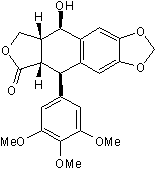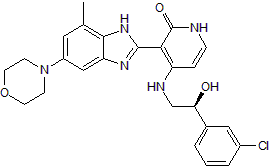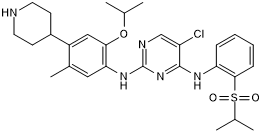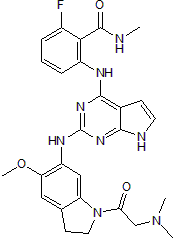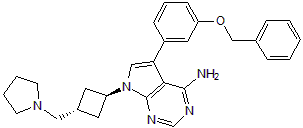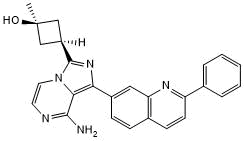IGF-I R/IGF1R: Small Molecules and Peptides
IGF-I R/IGF1R (Insulin-like Growth Factor I Receptor), also known as CD221, is a ubiquitously expressed heterotetrameric transmembrane glycoprotein consisting of two alpha and two beta subunits. It binds IGF-1 with high affinity, IGF2 with lower affinity, and Insulin with lowest affinity. IGF1R/Insulin R hybrids respond primarily to IGF-1 and may downregulate cellular responses to Insulin. IGF signaling is also modulated by IGF binding proteins and the scavenger receptor, IGF-II R/IGF2R. Mice lacking IGF1R show intrauterine growth deficiency and die at birth due to respiratory failure, and IGF1R mutations in humans can retarded pre- and postnatal growth. IGF-1 and its receptor are particularly important for neurogenesis, with deficiency producing microcephaly and learning disorders. IGF1R expression on human embryonic stem cells is important for their survival and clonogenicity.
Products:
8 results for "IGF-I R/IGF1R Small Molecules and Peptides" in Products
8 results for "IGF-I R/IGF1R Small Molecules and Peptides" in Products
IGF-I R/IGF1R: Small Molecules and Peptides
IGF-I R/IGF1R (Insulin-like Growth Factor I Receptor), also known as CD221, is a ubiquitously expressed heterotetrameric transmembrane glycoprotein consisting of two alpha and two beta subunits. It binds IGF-1 with high affinity, IGF2 with lower affinity, and Insulin with lowest affinity. IGF1R/Insulin R hybrids respond primarily to IGF-1 and may downregulate cellular responses to Insulin. IGF signaling is also modulated by IGF binding proteins and the scavenger receptor, IGF-II R/IGF2R. Mice lacking IGF1R show intrauterine growth deficiency and die at birth due to respiratory failure, and IGF1R mutations in humans can retarded pre- and postnatal growth. IGF-1 and its receptor are particularly important for neurogenesis, with deficiency producing microcephaly and learning disorders. IGF1R expression on human embryonic stem cells is important for their survival and clonogenicity.
Products:
Selective IGF1R inhibitor
| Alternate Names: | Picropodophyllin |
| Chemical Name: | (5R,5aS,8aR,9R)-5,8,8a,9-Tetrahydro-9-hydroxy-5-(3,4,5-trimethoxyphenyl)-furo[3',4':6,7]naphtho[2,3-d]-1,3-dioxol-6(5aH)-one |
| Purity: | ≥97% (HPLC) |
Dual IR/IGF1R inhibitor
| Chemical Name: | 4-[[(2S)-2-(3-Chlorophenyl)-2-hydroxyethyl]amino]-3-[7-methyl-5-(4-morpholinyl)-1H-benzimidazol-2-yl]-2(1H)-pyridinone |
| Purity: | ≥98% (HPLC) |
Highly potent ALK inhibitor; also potently inhibits IR, IGF1R, STK22D and FLT3
| Alternate Names: | LDK378 |
| Chemical Name: | 5-Chloro-N4-[2-[(1-methylethyl)sulfonyl]phenyl]-N2-[5-methyl-2-(1-methylethoxy)-4-(4-piperidinyl)phenyl]-2,4-pyrimidinediamine |
| Purity: | ≥98% (HPLC) |
IGF1R inhibitor
| Chemical Name: | N-(5-Chloro-2-methoxyphenyl)-N'-(2-methyl-4-quinolinyl)urea |
| Purity: | ≥99% (HPLC) |
Potent IR and IGF1R inhibitor; also inhibits anaplastic lymphoma kinase (ALK)
| Chemical Name: | 2-[[2-[[1-[(Dimethylamino)ethanoyl]-5-(methyloxy)-2,3-dihydro-1H-indol-6-yl]amino]-7H-pyrrolo[2,3-d]pyrimidin-4-yl]amino]-6-fluoro-N-methylbenzamide |
| Purity: | ≥98% (HPLC) |
ATP-competitive inhibitor of IGF1R
| Chemical Name: | 5-[3-(Phenylmethoxy)phenyl]-7-[trans-3-(1-pyrrolidinylmethyl)cyclobutyl]-7H-pyrrolo[2,3-d]pyrimidin-4-amine |
| Purity: | ≥99% (HPLC) |
High affinity insulin-like growth factor-I binding protein IGFBP inhibitor
| Chemical Name: | 1-(3,4-Dihydroxybenzoyl)-6,7-dihydroxy-3-isoquinolinecarboxylic acid |
| Purity: | ≥98% (HPLC) |
Potent and selective dual inhibitor of the IGF-1 receptor and insulin receptor
| Chemical Name: | cis-3-[8-Amino-1-(2-phenyl-7-quinolinyl)imidazo[1,5-a]pyrazin-3-yl]-1-methylcyclobutanol |
| Purity: | ≥98% (HPLC) |

